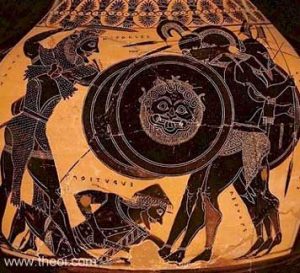The Autobiography of Red is inventive because of the continuous juxtaposition of modern-day life and mythology. The tale itself is a spin-off from the famous Greek myth, the Twelve Labors of Hercules; but Anne Carson poignantly spurns a revitalized depiction of Hercules, instead choosing to fasten her attention to one of antagonists – Geryon the monster. Hercules journeyed to the end of the world, an island called Erythia, to capture the cattle of Geryon for his tenth labor. Geryon was said to be a monstrous creature, with three heads and three sets of legs, born of the spawn of Medusa and the daughter of a Titan. As the legend goes, upon arrival on Erythia, Hercules slayed every creature that opposed him in effort to seize the oxen, including, the mighty Geryon came to stop his theft.
Anne Carson culls the idea of Hercules as the hero, opting to paint him as thief who took the livelihood of another for selfish purposes. In his stead, Carson anoints Geryon the status of protagonist of her tale, the little red monster who was bullied and broken into submission. Through her eyes, readers are taken on an expedition through the life of Geryon and the magnificent love affair that shattered his heart.
Carson emphasizes the parallels between old and new by sprinkling analogies to other moments in time. The personification of Geryon’s wings, the absence and/or presence of distress signals – being bound, covering them, flying – an allusion to the Icarus, who escaped from his life-long prison by the beautiful construction of wax wings but his celebration of his new freedom ultimately was the cause his death. Geryon’s compulsive obsession with photographing volcanos an allusion to the eruption of Mount Vesuvius entrapping the lives and stories of the people of Pompeii in its ash and magma.
By juxtaposing old and new, modern and myth, Carson accentuates the repetitive nature of our stories. All though some aspects of these stories change, some do not. It is these unchanging facets that Carson underscores: that queer narratives are forgotten, pushed aside in favor of heteronormativity. Through the inversion the tenth labor of Hercules in Autobiography of Red, Carson is sharing the untold truth of Geryon’s queer narrative.

Ann Carson’s juxtaposition of modern life and Greek mythology was a recurring aspect in Autobiography of Red that peeked my interest as well. However, I looked at the juxtaposition as a way to look into the histories of people. In other words, I found Ann Carson’s ties of Greek mythology and modern day life to be evidence that existing norms have always and will always be challenged. In mythology, monsters go against cultural norms, and in modern day life, queerness goes against gender and sexual norms. For me, the juxtaposition functioned as a way of mediating history and the present day, and to raise the question: how much have our views regarding nonconformity really evolved?
You mention that Carson inverts the narrative of The Twelve Labors of Hercules. I believe that this in itself is inventive. Carson inverts the story in many ways. She changes the protagonist and the antagonist, makes Geryon the focal point of the story, and adds queer thought and exploration to what appears to be a very heteronormative, hyper masculine portrayal of Hercules. I wonder if after reading Autobiography of Red, if you will see The Twelve Labors of Hercules differently, when you re-read it. Are there queer undertones present that were easily overlooked during a first-read?
I also wrote a bit about the juxtaposition of modernity and myth, although I focused more on poetic language. Still, I think our posts touch on related things. You talk about how “Carson accentuates the repetitive nature of our stories,” which I agree with. At the same time, Carson departs at least partially from tradition, both in her use of language and in the story she tells. By telling that untold queer narrative, Carson also alters tradition (this is working under the assumption that tradition is often heteronormative). She does not completely do away with traditional stories—this *is* based off of a Greek myth after all—but she changes them, drawing out a perspective that has historically been ignored.
Hi! I liked your discussion of Carson’s choice to focus on Geryon in her retelling of the story. Perhaps by focusing on this less well-known character, Carson is drawing parallels to focusing on groups that have traditionally been placed in roles that are less visible. I also think the story ends on an “up” note, which would also parallel greater visibility of the LGBTQ+ community.